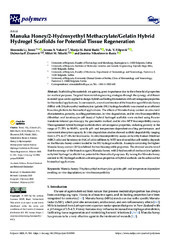Приказ основних података о документу
Manuka Honey/2-Hydroxyethyl Methacrylate/Gelatin Hybrid Hydrogel Scaffolds for Potential Tissue Regeneration
| dc.creator | Tomić, Simonida | |
| dc.creator | Vuković, Jovana | |
| dc.creator | Babić Radić, Marija | |
| dc.creator | Filipović, Vuk | |
| dc.creator | Živanović, Dubravka | |
| dc.creator | Nikolić, Miloš | |
| dc.creator | Nikodinović-Runić, Jasmina | |
| dc.date.accessioned | 2023-03-13T09:57:33Z | |
| dc.date.available | 2023-03-13T09:57:33Z | |
| dc.date.issued | 2023 | |
| dc.identifier.issn | 2073-4360 | |
| dc.identifier.uri | https://www.mdpi.com/2073-4360/15/3/589 | |
| dc.identifier.uri | https://imagine.imgge.bg.ac.rs/handle/123456789/1788 | |
| dc.description.abstract | Scaffolding biomaterials are gaining great importance due to their beneficial properties for medical purposes. Targeted biomaterial engineering strategies through the synergy of different material types can be applied to design hybrid scaffolding biomaterials with advantageous properties for biomedical applications. In our research, a novel combination of the bioactive agent Manuka honey (MHo) with 2-hydroxyethyl methacrylate/gelatin (HG) hydrogel scaffolds was created as an efficient bioactive platform for biomedical applications. The effects of Manuka honey content on structural characteristics, porosity, swelling performance, in vitro degradation, and in vitro biocompatibility (fibroblast and keratinocyte cell lines) of hybrid hydrogel scaffolds were studied using Fourier transform infrared spectroscopy, the gravimetric method, and in vitro MTT biocompatibility assays. The engineered hybrid hydrogel scaffolds show advantageous properties, including porosity in the range of 71.25% to 90.09%, specific pH- and temperature-dependent swelling performance, and convenient absorption capacity. In vitro degradation studies showed scaffold degradability ranging from 6.27% to 27.18% for four weeks. In vitro biocompatibility assays on healthy human fibroblast (MRC5 cells) and keratinocyte (HaCaT cells) cell lines by MTT tests showed that cell viability depends on the Manuka honey content loaded in the HG hydrogel scaffolds. A sample containing the highest Manuka honey content (30%) exhibited the best biocompatible properties. The obtained results reveal that the synergy of the bioactive agent, Manuka honey, with 2-hydroxyethyl methacrylate/gelatin as hybrid hydrogel scaffolds has potential for biomedical purposes. By tuning the Manuka honey content in HG hydrogel scaffolds advantageous properties of hybrid scaffolds can be achieved for biomedical applications. | |
| dc.language | en | |
| dc.publisher | MDPI | |
| dc.relation | This work was financed by the SCOPES program of the Swiss National Science Foundation (SNSF) and the Swiss Agency for Development and Cooperation (SDC) (Grant No. IZ73ZO_152327) | |
| dc.relation | info:eu-repo/grantAgreement/MESTD/Basic Research (BR or ON)/172062/RS// | |
| dc.relation | info:eu-repo/grantAgreement/MESTD/Basic Research (BR or ON)/172026/RS// | |
| dc.relation | info:eu-repo/grantAgreement/MESTD/inst-2020/200042/RS// | |
| dc.rights | openAccess | |
| dc.rights.uri | https://creativecommons.org/licenses/by/4.0/ | |
| dc.source | Polymers | |
| dc.source | Polymers | |
| dc.subject | 2-hydroxyethyl methacrylate | |
| dc.subject | gelatin | |
| dc.subject | in vitro biocompatibility | |
| dc.subject | in vitro degradation | |
| dc.subject | Manuka honey | |
| dc.subject | pH- and temperature-dependent swelling | |
| dc.title | Manuka Honey/2-Hydroxyethyl Methacrylate/Gelatin Hybrid Hydrogel Scaffolds for Potential Tissue Regeneration | |
| dc.type | article | en |
| dc.rights.license | BY | |
| dc.citation.issue | 3 | |
| dc.citation.rank | M21~ | |
| dc.citation.spage | 589 | |
| dc.citation.volume | 15 | |
| dc.identifier.doi | 10.3390/polym15030589 | |
| dc.identifier.fulltext | https://imagine.imgge.bg.ac.rs/bitstream/id/135292/Manuka_Honey2_Hydroxyethyl_MethacrylateGelatin_Hybrid_Hydrogel_Scaffolds_for_Potential_Tissue_Regeneration_2023.pdf | |
| dc.identifier.scopus | 2-s2.0-85147977576 | |
| dc.type.version | publishedVersion |

